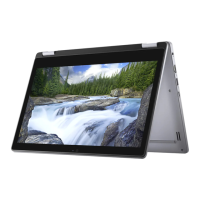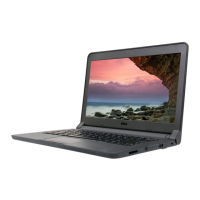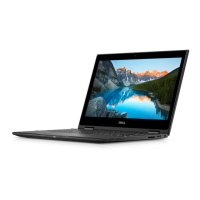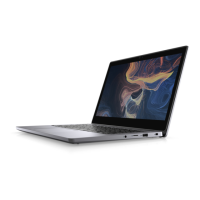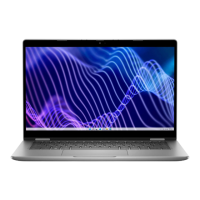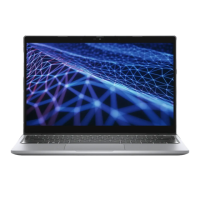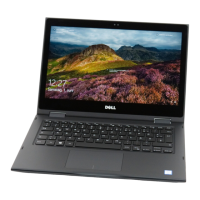Do you have a question about the Dell Latitude 3380 and is the answer not in the manual?
Guidelines to protect your computer from damage and ensure personal safety.
Preparation steps before opening the computer for maintenance or repair.
Procedure for safely shutting down the computer, specifically for Windows 10.
Steps to follow after completing internal computer maintenance or component replacement.
List of tools required for component removal and installation procedures.
Instructions for removing and installing the microSD card.
Instructions for removing and installing the computer's base cover.
Procedure for removing and installing the computer's battery.
Instructions for removing and installing the keyboard.
Instructions for removing and installing the Wireless Local Area Network (WLAN) card.
Procedure for removing and installing the system memory module.
Instructions for removing and installing the heat sink assembly.
Procedure for removing and installing the computer's internal system fan.
Instructions for removing and installing the hard disk drive (HDD).
Procedure for removing and installing the Embedded Multimedia Card (eMMC) assembly.
Instructions for removing and installing the DC-in connector/board.
Procedure for removing and installing the computer's audio board.
Instructions for removing and installing the coin cell battery.
Procedure for removing and installing the internal speakers.
Instructions for removing and installing the display assembly.
Procedure for removing and installing the main system board.
Information about the system's power adapter and its usage guidelines.
Details on the types of processors available for the system and how to identify them.
Information about the system's chipsets and how to identify them using Device Manager.
Options related to the computer's display settings, including resolution and brightness.
Technical details and differences of DDR4 memory compared to previous generations.
Details on the system's memory capabilities, verification, and testing methods.
Information on the system's integrated graphics chipsets.
An introduction to Universal Serial Bus features, evolution, speed, and compatibility.
Lists the types of hard drive options supported by the laptop and how to identify them.
Explanation of HDMI 1.4 features, advantages, and audio support.
Information about the integrated Realtek ALC3246 High Definition audio codec.
Details about the laptop's front-facing camera and how to start it.
How to change the boot device order and access boot menus.
Explanation of the keys used for navigating within the System Setup utility.
Provides an overview of what System Setup allows users to configure.
Instructions on how to enter the System Setup utility after system startup.
Lists primary hardware features and system information available in the General screen.
Options for configuring system hardware, drives, and USB features.
Options related to video settings, such as display brightness.
Options for setting system and user passwords to enhance security.
Options for configuring Secure Boot settings to enhance system security.
Options to adjust processor performance settings like core support and SpeedStep.
Settings related to power management, battery health, and system sleep modes.
Options that control system behavior during the Power-On Self Test (POST).
Options for enabling or disabling internal wireless devices like WLAN and Bluetooth.
System maintenance options, including BIOS downgrade and data wipe.
Options to view and clear system logs such as BIOS events and thermal events.
Settings for configuring the SupportAssist system resolution.
Steps to update the system BIOS from within the Windows operating system.
Information on setting system and setup passwords for security and access control.
General hardware specifications for the computer, including chipset and bus details.
Detailed specifications of the processors used in the system.
Details about the system's memory configuration, capacity, and speed.
Specifications for the storage drives, including HDD and SSD capacities and types.
Specifications related to the system's audio components and capabilities.
Specifications of the system's video and graphics components.
Specifications of the built-in front-facing camera.
Specifications for network adapters and wireless communication modules.
Details about the various ports and connectors available on the system.
Specifications of the laptop's display, including resolution and brightness.
Specifications related to the laptop's keyboard layout and key count.
Specifications of the laptop's touchpad, including resolution.
Specifications related to the laptop's battery, including capacity and lifespan.
Specifications for the AC adapter, including input and output voltages.
Physical dimensions and weight of the laptop.
Environmental operating conditions such as temperature and humidity.
Procedure to reset the Real Time Clock and BIOS defaults for system recovery.
Overview of the ePSA diagnostics tool for comprehensive hardware checks.
Step-by-step guide on how to initiate and run ePSA diagnostics on the system.
Instructions for contacting Dell for sales, technical support, or customer service issues.
Guidelines to protect your computer from damage and ensure personal safety.
Preparation steps before opening the computer for maintenance or repair.
Procedure for safely shutting down the computer, specifically for Windows 10.
Steps to follow after completing internal computer maintenance or component replacement.
List of tools required for component removal and installation procedures.
Instructions for removing and installing the microSD card.
Instructions for removing and installing the computer's base cover.
Procedure for removing and installing the computer's battery.
Instructions for removing and installing the keyboard.
Instructions for removing and installing the Wireless Local Area Network (WLAN) card.
Procedure for removing and installing the system memory module.
Instructions for removing and installing the heat sink assembly.
Procedure for removing and installing the computer's internal system fan.
Instructions for removing and installing the hard disk drive (HDD).
Procedure for removing and installing the Embedded Multimedia Card (eMMC) assembly.
Instructions for removing and installing the DC-in connector/board.
Procedure for removing and installing the computer's audio board.
Instructions for removing and installing the coin cell battery.
Procedure for removing and installing the internal speakers.
Instructions for removing and installing the display assembly.
Procedure for removing and installing the main system board.
Information about the system's power adapter and its usage guidelines.
Details on the types of processors available for the system and how to identify them.
Information about the system's chipsets and how to identify them using Device Manager.
Options related to the computer's display settings, including resolution and brightness.
Technical details and differences of DDR4 memory compared to previous generations.
Details on the system's memory capabilities, verification, and testing methods.
Information on the system's integrated graphics chipsets.
An introduction to Universal Serial Bus features, evolution, speed, and compatibility.
Lists the types of hard drive options supported by the laptop and how to identify them.
Explanation of HDMI 1.4 features, advantages, and audio support.
Information about the integrated Realtek ALC3246 High Definition audio codec.
Details about the laptop's front-facing camera and how to start it.
How to change the boot device order and access boot menus.
Explanation of the keys used for navigating within the System Setup utility.
Provides an overview of what System Setup allows users to configure.
Instructions on how to enter the System Setup utility after system startup.
Lists primary hardware features and system information available in the General screen.
Options for configuring system hardware, drives, and USB features.
Options related to video settings, such as display brightness.
Options for setting system and user passwords to enhance security.
Options for configuring Secure Boot settings to enhance system security.
Options to adjust processor performance settings like core support and SpeedStep.
Settings related to power management, battery health, and system sleep modes.
Options that control system behavior during the Power-On Self Test (POST).
Options for enabling or disabling internal wireless devices like WLAN and Bluetooth.
System maintenance options, including BIOS downgrade and data wipe.
Options to view and clear system logs such as BIOS events and thermal events.
Settings for configuring the SupportAssist system resolution.
Steps to update the system BIOS from within the Windows operating system.
Information on setting system and setup passwords for security and access control.
General hardware specifications for the computer, including chipset and bus details.
Detailed specifications of the processors used in the system.
Details about the system's memory configuration, capacity, and speed.
Specifications for the storage drives, including HDD and SSD capacities and types.
Specifications related to the system's audio components and capabilities.
Specifications of the system's video and graphics components.
Specifications of the built-in front-facing camera.
Specifications for network adapters and wireless communication modules.
Details about the various ports and connectors available on the system.
Specifications of the laptop's display, including resolution and brightness.
Specifications related to the laptop's keyboard layout and key count.
Specifications of the laptop's touchpad, including resolution.
Specifications related to the laptop's battery, including capacity and lifespan.
Specifications for the AC adapter, including input and output voltages.
Physical dimensions and weight of the laptop.
Environmental operating conditions such as temperature and humidity.
Procedure to reset the Real Time Clock and BIOS defaults for system recovery.
Overview of the ePSA diagnostics tool for comprehensive hardware checks.
Step-by-step guide on how to initiate and run ePSA diagnostics on the system.
Instructions for contacting Dell for sales, technical support, or customer service issues.
| Form factor | Clamshell |
|---|---|
| Product type | Laptop |
| Product color | Black, Grey |
| Market positioning | Educational |
| Memory slots | 1x SO-DIMM |
| Internal memory | 4 GB |
| Memory clock speed | 2133 MHz |
| Memory form factor | SO-DIMM |
| Internal memory type | DDR4-SDRAM |
| Maximum internal memory | 8 GB |
| Memory layout (slots x size) | 1 x 4 GB |
| 3D | No |
| AC adapter included | Yes |
| HDD size | 2.5 \ |
| HDD speed | 7200 RPM |
| HDD interface | SATA |
| Storage media | HDD |
| Total storage capacity | 500 GB |
| Compatible memory cards | SD |
| Number of HDDs installed | 1 |
| Pixel pitch | 0.2148 x 0.2148 mm |
| Display surface | Matt |
| Display diagonal | 13.3 \ |
| Display brightness | 200 cd/m² |
| Display resolution | 1366 x 768 pixels |
| Native aspect ratio | 16:9 |
| On-board graphics card ID | 0x5906 |
| Discrete graphics card model | Not available |
| On-board graphics card model | Intel® HD Graphics 610 |
| Maximum on-board graphics card memory | 32 GB |
| On-board graphics card OpenGL version | 4.4 |
| On-board graphics card base frequency | 300 MHz |
| On-board graphics card DirectX version | 12.0 |
| On-board graphics card dynamic frequency (max) | 900 MHz |
| Audio chip | Realtek ALC3246 |
| Speaker power | 2 W |
| Number of built-in speakers | 2 |
| Front camera resolution | 1280 x 720 pixels |
| Front camera resolution (numeric) | 1 MP |
| Wi-Fi standards | Wi-Fi 5 (802.11ac) |
| Bluetooth version | 4.1 |
| Ethernet LAN data rates | 10, 100, 1000 Mbit/s |
| Charging port type | DC-in jack |
| USB 2.0 ports quantity | 0 |
| USB 3.2 Gen 1 (3.1 Gen 1) Type-A ports quantity | 3 |
| Pointing device | Touchpad |
| Operating system architecture | 64-bit |
| Battery voltage | 11.4 V |
| Battery capacity | 56 Wh |
| Number of battery cells | 4 |
| AC adapter power | 65 W |
| AC adapter frequency | 50 - 60 Hz |
| AC adapter input voltage | 100 - 240 V |
| AC adapter output current | 3.34 A |
| AC adapter output voltage | 19.5 V |
| Cable lock slot type | Noble |
| Operating altitude | 0 - 3048 m |
| Non-operating altitude | 0 - 10668 m |
| Storage temperature (T-T) | -40 - 65 °C |
| Operating temperature (T-T) | 0 - 35 °C |
| Storage relative humidity (H-H) | 5 - 95 % |
| Operating relative humidity (H-H) | 10 - 90 % |
| Sustainability certificates | ENERGY STAR |
| Bus type | OPI |
| Tjunction | 100 °C |
| Processor cache | 2 MB |
| System bus rate | 4 GT/s |
| Processor family | Intel® Celeron® |
| Processor codename | Kaby Lake |
| Processor frequency | 1.8 GHz |
| Processor cache type | Smart Cache |
| Configurable TDP-down | 10 W |
| Processor lithography | 14 nm |
| Processor manufacturer | Intel |
| PCI Express slots version | 2.0 |
| PCI Express configurations | 1x2+2x1, 1x4, 2x2, 4x1 |
| Thermal Design Power (TDP) | 15 W |
| Maximum number of PCI Express lanes | 10 |
| Processor ARK ID | 96507 |
| Processor package size | 42 x 24 mm |
| Supported instruction sets | SSE4.1, SSE4.2 |
| Intel Secure Key Technology version | 1.00 |
| Intel Stable Image Platform Program (SIPP) version | 0.00 |
| Depth | 231.8 mm |
|---|---|
| Width | 332.9 mm |
| Height | 23 mm |
| Weight | 1630 g |


